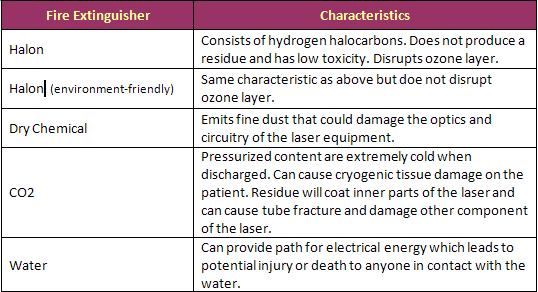Nominal Hazard Zone
“The space within which level of the direct, reflected or scattered radiation during normal operation exceeds the applicable Maximum Permissible Exposure (MPE).” Guide for the Safe Use of Lasers” (ANSI Z136.1 – 2005),
Nominal Hazard Zone (NHZ) can be calculated using a laser range equation that take into account the laser wavelength, beam divergence, laser power, beam size at the aperture and/or lens, lens focal length, and range from the laser to the target. The NHZs vary depending on the wavelengths that are delivered through fibers. To simply this situation, NHZ is considered to be within the treatment area or the surgery room.
Maximum Permissible Exposure
“is the level of laser radiation to which a person may be exposed without hazardous effects or adverse biological changes in the eye or skin” Guide for the Safe Use of Lasers” (ANSI Z136.1 – 2005),
Eye Protection
Implementing eye safety measures is of paramount importance during laser procedures. MAXIMUM measures should be implemented to provide OPTIMUM eye protection. Eye damage depends on the laser wavelength. Even low levels of laser radiation can cause permanent eye damage.
Patient’s eyes should be protected at all times during laser procedures. Eye protection may include but not limited to laser safety eyewear, wet eye pads, protective metal eye shields, wet towels, wet drapes as deemed appropriate.
Prescription glasses are not recommended as appropriate protection because the glass or plastic material may not absorb the laser beam adequately, and subsequent transmission of the beam to the eyes could occur.
Contact lenses do not protect part of the eye which is the sclera, thereby rendering insufficient protection for the eyes.
“The use of laser protective eyewear is mandatory with Class IV lasers. Protective
eyewear shall be fabricated of plastic or glass absorption filters appropriate for the laser. All laser protective eyewear shall be clearly labeled with optical density values and wavelengths for which protection is afforded.” STD 01-05-001 - PUB 8-1.7 – Guidelines for Laser Safety and Hazard Assessment, OSHA Directive
Per OSHA, “LASER EYEWEAR MUST BE ON BEFORE THE LASER CAN BE TURNED ON” STD 01-05-001 - PUB 8-1.7 – Guidelines for Laser Safety and Hazard Assessment, OSHA Directive
For best and safe practices, laser eye protection should always be used in case unexpected or unusual events occur that could cause eye damage.
Fire Extinguishers
Characteristics of each fire extinguisher should be considered proactively when dealing with fire safety. Laser users or personnel charged to operate the laser unit should be aware of the location of the closest available fire extinguisher.
There several types of fire extinguishers. Each type has different characteristics.

Endotracheal Tube
Unprotected polyvinyl chloride (PVC) ET tube must never be used during oral or laryngeal laser surgeries. PVC ET tubes can be ignited by a laser beam and will support combustion. PVC ET tubes are extremely flammable. ET tubes made specifically for laser procedures are available for use for specific wavelengths, examples are Laser Tube (Rusch), Laser-Flex (Mallinckridt), Laser-Shield (Medtronics). Follow manufacturer’s recommendations on the safe use of these products.
Laser resistant endotracheal tubes approved by FDA shall be inflated with fluid or per manufacturer’s recommendation and externally protected with wet cottonoids. Lowest concentration of oxygen shall be used in laryngeo-tracheal procedures.
Emergency Tracheotomy kit/tray will be made available in all laser airway cases for use in the event of an emergency. The kit need not be opened unless it is required.
Water
A container of water should be kept readily available during all laser procedures for immediate dousing of fire if needed.
Masks
High-filtration masks with a filtering capacity of particulate matter 0.1 µm in size should be worn by surgical team members during any procedure that generate plume.
To decrease the chance of inhaling hazardous matter, masks should be worn properly, covering the nose and mouth. The sides of the mask should conform to the face adequately.
Display of Warning Signs
Specific laser warning signs shall be conspicuously displayed on ALL doors leading to the laser treatment area. Warning signs should be covered, switched off, or removed when the laser is not in use.
Laser Keys
For laser systems equipped with a key switch to prevent unauthorized use, the key must not be left in the switch when the laser system is unattended. Keys should be kept in a specified area.
Other safety measures:
- Solution bottles should never be placed on top of the laser unit to prevent spillage or splatter on the internal circuitry of the laser unit.
- Foot pedals should be kept dry and protected from water or other fluids.
- Protective covering of laser units should never be removed by unauthorized personnel because of the risk of electric shock and electrocution.
- Laser unit should be at least 12 inches away from walls to allow air to circulate and cool the internal system during laser operation.
- When transporting laser units, care must be taken to prevent the unit from being jarred or hit solid objects that may cause damage to laser components.



